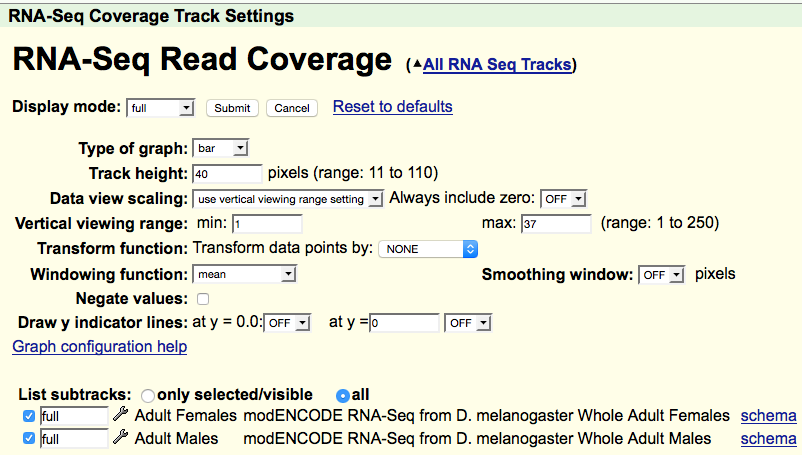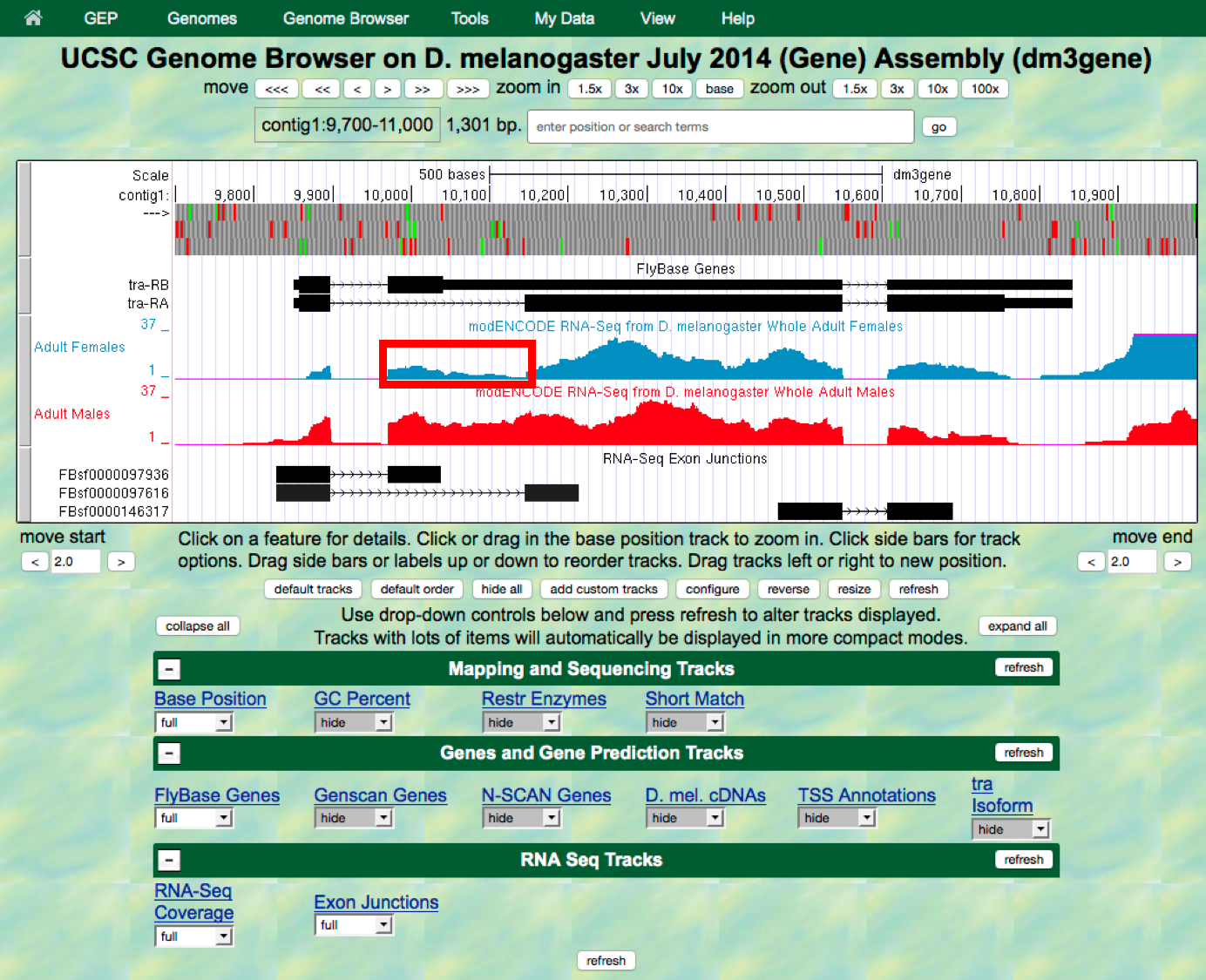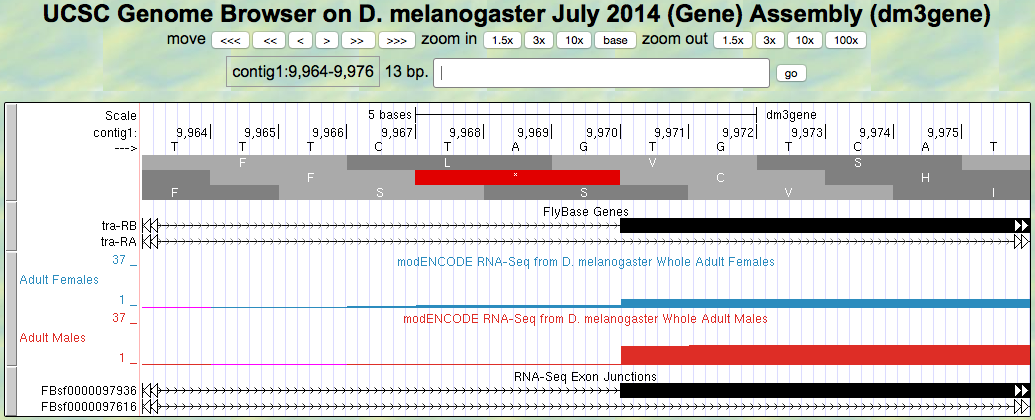6. Module 6¶
Module 6: Alternative splicing
| Author: | Leocadia Paliulis (Bucknell University) |
|---|---|
| Last Update: | Jan 08, 2020 |
| Version: | 0.0.1 |
6.1. Investigation 1: Construct the gene model for tra-RB¶
Learning Objectives
- Identify how alternative splicing of a gene can lead to different mRNAs.
- Identify how alternative splicing can lead to the production of different polypeptides.
In this investigation, we will focus on tra-RB, the second isoform of the tra gene, and will explore how multiple different mRNAs and polypeptides can be encoded by the same gene. The story of tra-RB is an exciting story of sex, alternative splicing, and poison exons!
- To begin, open a web browser
- Go to the UCSC Genome Browser Mirror site at
http://gander.wustl.edu/ and follow the instructions given in
Module 1 to open
contig1of Drosophila melanogaster, using theJuly 2014 (Gene)assembly rather than the “Aug. 2014 (BDGP Release 6 + ISO1 MT/dm6)” assembly. Once you are on the Genome Browser page, set “Base Position” (under the “Mapping and Sequencing Tracks” bar) tofullso that you will be able see the three possible reading frames (remember that you will not see individual bases or amino acids until you zoom in, though). Also set “FlyBase Genes” (under the “Genes and Gene Predictions” bar) tofull. Don’t forget to click on one of therefreshbuttons to see your changes. - Enter the following coordinates into the “enter position or
search terms” text box:
contig1:9,700-11,000and hit thegobutton to get a good view of the tra gene (Figure 6.1).

Figure 6.1. Center the browser on the tra gene.
- Let’s consider what we know about tra-RA and learn more about tra-RB.
Question 1
Given that exons are shown by the black boxes, and introns are shown by thin lines with arrowheads in the FlyBase Genes track, what does this tell us about the first intron of tra-RB compared to that of tra-RA?
- Now let’s look at the patterns of transcription. Scroll down
to “RNA Seq Tracks”, click on the
RNA-Seq Coveragelink. Change the track display settings as we did in Module 2:- Set the “Display mode” to
full - Set the “Data view scaling” field to
use vertical viewing range setting - Set the “max” field under “Vertical viewing range” to
37 - Check both
Adult FemalesandAdult Malesunder “List subtracks” - Hit the
Submitbutton (Figure 6.2)
- Set the “Display mode” to

Figure 6.2. Enter settings for RNA Seq tracks.
- Back on the browser main page
- Under “RNA Seq Tracks”, change the display mode for the
“Exon Junctions” track to
full, then hitrefresh.
- Under “RNA Seq Tracks”, change the display mode for the
“Exon Junctions” track to
Tip
To review the use of RNA Seq data, watch the RNA Seq and TopHat video
Now we can see the RNA-Seq data for males (red) and females (blue). Recall that peaks in RNA-Seq Read Coverage tracks usually correspond to the regions of the genome that are being transcribed. These two samples generally show similar RNA-Seq read coverage along the entire span of the tra gene. However, the adult female sample shows substantially lower RNA-Seq read coverage at around 9,971-10,145 (red box in Figure 6.3). We can also see the RNA-Seq Exon Junctions track, which shows the location of splice sites supported by the RNA-Seq data (as you saw in Module 4). Recall that the black boxes in the FlyBase Genes track are exons and the thin lines with arrowheads show the locations of the introns. Notice that the diagrams for the first and second RNA-Seq Exon Junctions tracks have the same 5’ splice site but different 3’ splice sites. Let’s see what we can find out about these splice sites.

Figure 6.3. Browser showing gene predictors, RNA-Seq tracks, and RNA-Seq exon junctions for male and female Drosophila melanogaster.
- First, we need to establish the reading frame for the first exon. Zoom
in on the 5’ end of the transcript around position
contig1:9850-9860.
Question 2
Given what you know about the initiation of translation, which of the 3 possible reading frames is used for both the tra-RA and tra-RB products?
- Now zoom in on the location of the 5’ splice site at the end of the first exon in both tra-RA and tra-RB (Figure 6.4). We will also be thinking about the concept of phase here. To review splicing and phase, watch the Splicing and Phase video.

Figure 6.4. Zoom in on the first 5’ splice site.
Question 3
Give the coordinate for the last base of the first exon for tra-RA.
Question 4
Give the coordinate for the last base of the first exon for tra-RB.
Question 5
What is the consensus sequence for the 5’ splice site (donor site)?
Question 6
What are the coordinates for the 5’ splice site in tra-RA?
Question 7
What are the coordinates for the 5’ splice site in tra-RB?
Question 8
What is the phase at this splice site?
- Now zoom out and zoom in on the start of the second exon in tra-RB, just after the 3’ splice site (Figure 6.5). We can identify the second exon by the RNA-Seq data, in particular using the RNA-Seq Exon Junctions data.

Figure 6.5. Zoom in on the start of second exon in tra-RB.
Question 9
What are the coordinates for the first base of the second exon in tra-RB?
Question 10
What is the consensus sequence for the 3’ splice site?
Question 11
What are the coordinates for the 3’ splice site in intron 1 of tra-RB?
Question 12
What phase do we anticipate?
Question 13
Given this, what is the reading frame for tra-RB exon2?
Question 14
Does this make sense, given the location of stop codons?
- Now zoom out and zoom in on the 3’ splice site for tra-RA. (Figure 6.6). This can be identified from the RNA-Seq data, particularly the RNA-Seq Exon Junctions.

Figure 6.6. Zoom in on start of second exon for tra-RA.
Question 15
What are the coordinates for the first base of the second exon in tra-RA?
Question 16
What is the consensus sequence for the 3’ splice site?
Question 17
What are the coordinates for that sequence in intron 1 of tra-RA?
Question 18
Given the phase at the donor site, what phase are we looking for here?
Question 19
Given this, what is the reading frame for tra-RA exon 2?
Question 20
Does this make sense, given the location of stop codons?
The 3’ acceptor site for the second intron in tra-RA is found inside the second exon of tra-RB. This intron is alternatively spliced. Alternative splicing is one way eukaryotes produce different proteins from the same coding regions of DNA. Here the alternative decision is made in a sex-specific manner; male fruit flies have targeted the spliceosome to use the first 3’ acceptor site identified by the RNA-Seq Exon Junction data, while female fruit flies have targeted the spliceosome to use the second 3’ acceptor site identified. This change in splicing has profound effects — in fact, it drives the programming of male and female characteristics in the developing fly. To review alternative splicing, watch the Genes and Isoforms video.
- Reset your browser by entering
contig1:9,700-11,000into the “enter position or search terms” text box and hitgo. Let’s analyze the consequences of this alternative splicing on production of a protein product.
Question 21
From your analysis of the A isoform of tra in Module 5, how many amino acids does the tra-RA protein product have?
Now look at the tra-RB isoform:
Question 22
What are the coordinates for exon 1?
Question 23
Given the reading frame that you established for tra-RB, does translation continue past exon 2, or is it terminated by a stop codon in exon 2?
Question 24
What are the coordinates for the translated portion of exon 2?
Question 25
How many amino acids does the protein translated from the tra-RB isoform have?
Question 26
Is it likely that the protein translated from tra-RB could play the same functional role played by the protein translated from tra-RA?
Note
The Tra protein has an important function in female Drosophila, and is itself a splicing factor that regulates splicing. Careful annotation of genes, as we have done here, can provide many insights into biological control mechanisms.
6.2. Investigation 2: Polypeptides produced from each isoform of tra¶
Learning Objectives
- Describe how alternative splicing producing different polypeptides might result in changes in phenotype.
Now that we know that tra is alternatively spliced to make two isoforms, tra-RA and tra-RB, and that males express one isoform while females express the other, let’s try to figure out how alternative splicing affects the polypeptides produced from translating these mRNAs. To do this, we need to produce a gene model for tra-RB and compare it to the gene model for tra-RA that you constructed in Module 5, showing where the start codons and stop codons appear in each isoform.
Use what you learned in Module 5 to construct a gene model for tra-RB. Locate the start codon, splice sites, and the stop codon. Construct the gene model below.
Question 27
Gene model for tra-RB:
- Coordinate for start of translation: ______________
- Coordinate for last base of exon 1: ______________
- Coordinate for first base of exon 2: ______________
- Coordinate for last base of exon 2: ______________
- Coordinate for first base of exon 3: ______________
- Stop codon coordinates: ___________________________
6.3. Summary¶
Summary Question 1
How does the polypeptide translated from the tra-RB isoform differ from the polypeptide translated from the tra-RA isoform? What are the consequences of these differences on protein function?
Summary Question 2
Discuss how the bigger mRNA leads to creation of a smaller polypeptide!!
Summary Question 3
Consider how alternative splicing could allow many different proteins to be encoded by the same gene.
Summary Question 4
Based on the gene structure of the two isoforms of tra shown in the “FlyBase Genes” track, provide a hypothesis that could explain this difference in RNA-Seq read coverage between the adult males sample and adult females sample.